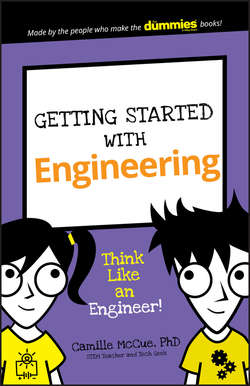Читать книгу Getting Started with Engineering - McCue Camille - Страница 3
PROJECT 1
ENGINEERING 101
ОглавлениеWELCOME TO ENGINEERING! You are beginning an adventure that explores the fun and rewarding field of engineering. Because engineering is not a class most kids see on their school schedules, we’ll start with a crash course in Engineering 101.
WHAT IS ENGINEERING?
Engineering is work that uses science, math, and technology to create products and processes. The mission of engineering work is to help humanity and our world. Many times, the goal is to solve an urgent problem, such as building a bridge or setting up a communications network after a disaster. Sometimes, the goal of engineering is to help other living creatures, such as developing prosthetic (artificial) legs for a dog born with missing or malformed limbs. Other times, the goal of engineering is to make a process work better and faster, such as scheduling the gates that airplanes use in an airport.
Courtesy of 3D Systems
WHERE DO ENGINEERS WORK?
Engineers work in all types of settings, all over the world. Sometimes engineers work inside, using a computer to design a product. Sometimes they work outside, using special construction equipment to build a structure. Sometimes they work alone, but most of the time engineers work in teams.
Engineers share information with each other when the knowledge and experience of one group can help another group. This was the case when NASA engineers helped the government of Chile rescue 33 miners who were trapped underground. NASA’s experience working in hard-to-reach places and in creating rescue capsules contributed to the success in saving the miners.
Courtesy of Hugo Infante/Government of Chile
WHAT ARE SOME ENGINEERING FIELDS?
Many types of engineering exist, and each field offers exciting challenges to solve. Here are a few engineering fields and the products or processes with which they work:
Aerospace: Build airplanes and spacecraft
Architectural: Construct buildings, skyscrapers, and landmarks
Biomedical: Build devices that function with living bodies
Chemical/materials: Create new products such as medicines, plastics, and fuels
Civil/structural: Build dams, roads, and bridges
Computer: Make computers and smart devices
Electrical: Build electronic equipment; generate and distribute electricity to homes and factories
Environmental: Focus on pollution control and recycling
Entertainment: Build amusement parks and movie sets
Industrial: Find ways to speed up and improve production lines
Marine/ocean: Design systems to operate in coastal or ocean waters
Mechanical: Design and build machines, including robots
Mining/geological: Focus on mining and earthquakes
Nuclear: Build systems that use the energy of atomic radiation
Petroleum: Find, get, and use oil and natural gas for energy
The Grand Challenges of Engineering are some of the most important work engineers will need to do to help humanity. Learn about them at www.engineeringchallenges.org.
WHAT IS THE ENGINEERING DESIGN CYCLE?
The Engineering Design Cycle, or simply, the Engineering Cycle, is a set of steps an engineer follows to go from an idea or a need to a manufactured product or a process. When an engineer makes a product, such as a spacecraft to go to Mars or a roller coaster, he or she follows this cycle:
Design: Start with information about a need or a problem, brainstorm ideas on how to solve it, choose one, and then draw how you will make your product in real life.
Build: Use tools and materials to construct your product. A prototype is the first build of a product, before it is perfect.
Test: Use your product to find out how well it works.
Improve: Make changes to your product to fix the parts that don’t work well.
When an engineer creates a process, such as cleaning an ocean oil spill or speeding up the way people move across a bridge, he or she follows this cycle:
Plan: Start with information about the problem or need, brainstorm ideas about how to address the need, choose one, and then write down the steps for how you will make your proposed process work, start to finish, in real life.
Implement: Perform your process using the steps of your plan.
Evaluate: Decide how well your process works.
Improve: Make changes in your process to speed up or simplify the parts that don’t work well.
The Engineering Cycle is a cycle because you continue looping through the steps to constantly improve your product or process.
Конец ознакомительного фрагмента. Купить книгу
